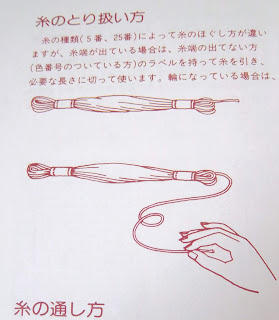Every year I create ornaments for my younger nieces and nephews, the ones who haven't graduated from high school yet. I like to get these made early and out of the way since I always have other gifts to make. Here's what I stitched up for this year's set:
And a close-up:
Each design was stitched on 14-count Aida fabric, trimmed, backed with coordinating felt and then glued to wooden rings. A friend of mine gave me those rings, which came wrapped with wire hangers. They were the perfect size for the finished stitcheries. I'll admit, though, that these aren't big ornaments - the wooden rings are only about 2" diameter. So, small ornaments, but big on charm.
What makes the source of these designs unusual is this:
A 1979 counted cross-stitch design book, published by the Japanese company Ondori. (In case you didn't know, the letters "DMC" on the front cover refer to a well-known embroidery thread company). I bought this book at a thrift store for a quarter. I liked the interesting - and sometimes goofy - designs, but it was the cheery colors that really caught my eye:
A friend thought these figures looked Dutch.
These chicks would be cute for Easter.
A pig in pink.
The page from which my ornament designs came.
For reasons unknown to me, several of the larger designs in this book depict some sort of circus or carnival setting, such as this one:
Children on an animal-themed ride.
Other designs along the same theme are children holding balloons, hot air balloons rising up in the sky beyond a roller coaster and a Ferris wheel, clowns riding a circus wagon being pulled by an ostrich, clowns doing an act with a monkey, and other whimsical scenes.
The purpose of these - or any of the designs in this book - is unknown to me as well, since nearly the entire book is in Japanese. But the design charts were easy to follow and the DMC color numbers were given for each design. Those numbers are universal, so I had no problem doing the stitching.
I was curious about this:
Might have included some handy tips about how to pull out an end of the floss without ending up with a tangled mess like I've sometimes done. But it'll remain a mystery to me.
This book is 120 pages long plus four pages of ads for other Ondori craft books. The only real English in the whole volume is two snippets added later: the American importer of the book and the shop in my area that had stocked it.
Although Japanese language craft books are still a thing in this country, I don't see them around much, so I do consider them an unusual source. But in this case, my thrift store find helped me with some Christmas gift-giving. There's nothing unusual about that!

















